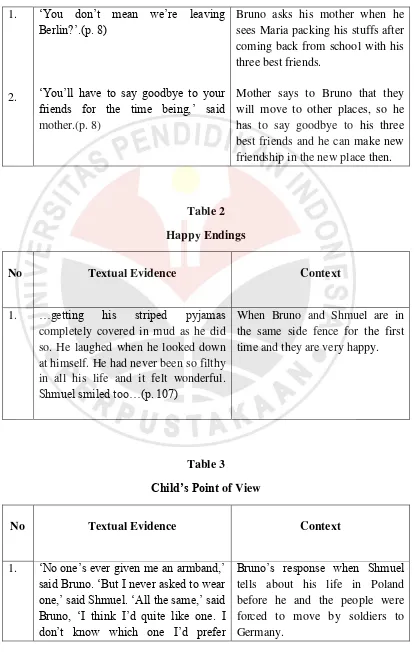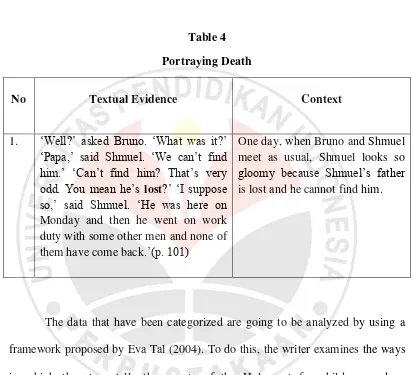CHAPTER III
RESEARCH METHODOLOGY
This chapter discusses the methodology of the research which covers the research question, research method, stages of the research, data source, data
collection, and data analysis.
3.1. Research Question
The research is conducted to answer following question:
1. In what way(s) does the story tell the events of the Holocaust for children
readers?
3.2. Research Method
This research is a textual analysis of John Boyne’s novel entitled The Boy
in the Striped Pyjamas. It employs qualitative method in the form of descriptive
analysis of the textual evidences. Sutopo (2006) points out that qualitative method is a method that uses data in words, sentences, or picture which have more meanings and comprehensions rather than number or frequency. The textual
tells the events of the Holocaust for children’s readers. The research employs the
framework to examine holocaust children’s literature as proposed by Eva Tal (2004).
3.3. Research Procedures
In conducting the research, the following steps have been undertaken:
1. Formulating research question and deciding object of the research.
2. Reading and re-reading the novel closely to get a solid comprehension of
issue in the story.
3. Finding textual evidences in the form of words, phrases, and sentences.
4. Categorizing textual evidences as proposed by Eva Tal (2004) by: Finding an appropriate representation of death and suffering, designing happy endings, telling the story from a child’s point of view, and using
symbolism and figurative language to portray death.
5. Analyzing and interpreting the collected data using Eva Tal’s (2004)
framework to answer the research question, and analyzing symbolisms as data interpreting method.
3.4. Data Source
The data of the research are collected from John Boyne’s novel entitled
The Boy in the Striped Pyjamas. The novel tells about the same-age-boys’
friendship who lived in World War II and disastrous consequences of a friendship across a divide –separated by the fence and cramped by their labels, Nazi and
Jewish.
The novel has been chosen as the data source because it contains the issue of the Holocaust and,-Jewish genocide in World War II, which interestingly is
intended for children readers.
3.5. Data Collection and Data Analysis
The textual evidences of this research are in form of words or symbolisms, sentences, and utterances of the characters who involved in the story which
contain the ways the story tells the events of the Holocaust for children readers proposed by Eva Tal (2004) which have been elaborated in the previous chapter.
The collected data are presented in a table below, for instance:
Table 1
Narrative Structure
1. sees Maria packing his stuffs after coming back from school with his three best friends.
Mother says to Bruno that they will move to other places, so he has to say goodbye to his three best friends and he can make new friendship in the new place then.
Table 2
Happy Endings
No Textual Evidence Context
1. …getting his striped pyjamas completely covered in mud as he did so. He laughed when he looked down at himself. He had never been so filthy in all his life and it felt wonderful. Shmuel smiled too…(p. 107)
When Bruno and Shmuel are in the same side fence for the first time and they are very happy.
Table 3
Child’s Point of View
No Textual Evidence Context
1. ‘No one’s ever given me an armband,’ said Bruno. ‘But I never asked to wear one,’ said Shmuel. ‘All the same,’ said
though, your one or Father’s.’(p. 68)
Table 4
Portraying Death
No Textual Evidence Context
1. ‘Well?’ asked Bruno. ‘What was it?’ ‘Papa,’ said Shmuel. ‘We can’t find him.’ ‘Can’t find him? That’s very odd. You mean he’s lost?’ ‘I suppose
so,’ said Shmuel. ‘He was here on Monday and then he went on work duty with some other men and none of them have come back.’(p. 101)
One day, when Bruno and Shmuel meet as usual, Shmuel looks so gloomy because Shmuel’s father is lost and he cannot find him.
The data that have been categorized are going to be analyzed by using a framework proposed by Eva Tal (2004). To do this, the writer examines the ways
in which the story tells the events of the Holocaust for children readers. Furthermore, the writer analyzes the symbolisms which are presented in the


